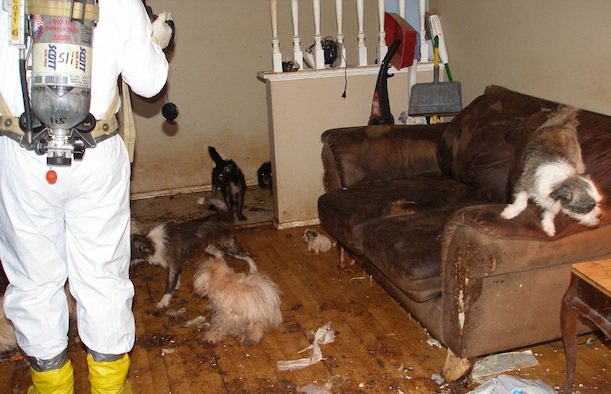
Animal hoarding, sometimes referred to as "collecting", continues to struggle with public misconceptions. Members of the community and even law enforcement often view hoarders to be "someone who meant well but the situation got out of hand," conjuring images of the sweet cat lady down the street.
While their intentions may indeed have been good, the reality of hoarding is far from sweet, and is often quite horrific. Hoarders often have hundreds of animals in their home, living in filth and without veterinary care. It is not uncommon to discover several hundred animals in various states of neglect at one location. It is also very common to find vast collections of other junk and garbage on the premises, as well as many layers of feces throughout the home.
In the majority of hoarding cases, the hoarder firmly believes not only that they have done nothing wrong, but that the animals cannot survive without their "care". In many instances, hoarders will even be reluctant to relinquish the decomposing corpses of animals that died. Dead animals are frequently found in the freezer or refrigerator, or even laying around the house, embedded in the carpeting, etc. At times, dead animals have been left in the home so long that they have become mummified.
Hoarders may feel that they "love" animals, but they can be blind to the fact that they are not caring for them responsibly even in the face of starvation and death. Hoarders are usually unable to bear the thought of euthanasia, but vast numbers of animals are "saved" only to languish in a squalid, crowded environment where they suffer from malnourishment, illness, inactivity, poor ventilation, and lack of human companionship. Dogs and cats have been found kept in cages, crates, hutches, and even kitchen cabinets, some even being allowed to breed. Hoarders often cannot afford to pay for all the spaying and neutering (not to mention the routine veterinary care) needed for so many animals, so their collection grows until the filth, stench, and noise attract the attention of neighbors or health, sanitation, or humane officials. In some situations, the homes of animal hoarders are so run-down and filthy that the local Department of Health actually orders their homes razed to the ground.
Despite a correlation to the psychological condition of Obsessive Compulsive Disorder (OCD), there is no clinical diagnosis at this point. More research is needed. Gary Patronek, director of the Center for Animals and Public Policy at Tufts University, states "We'd like to study it more," he says. "Is it a syndrome in and of itself? Probably not. But [one day] we might like it to be included as a warning sign [in psychological evaluation]."
"Perhaps the most prominent psychological feature of these individuals is that pets (and other possessions) become central to the hoarder's core identity," Patronek writes in Municipal Lawyer magazine. "The hoarder develops a strong need for control, and just the thought of losing an animal can produce an intense grief-like reaction. Preliminary HARC interviews also suggest that hoarders grew up in chaotic households, with inconsistent parenting, in which animals may have been the only stable feature."
Some studies indicate that a recurring theme in animal hoarders may be situations of neglect or loss in their childhood. To oversimplify, they attempt to fill their lives with the consistent love they feel they were (or are) lacking. Many hoarders believe they are on a mission to save animals - for this reason, we see hoarding more prevalent in animal rescuers than any other type of animal cruelty. Recidivism in animal hoarders is nearly 100%.
While the "typical" animal hoarder is very often elderly, and quite often female, recent statistics indicate that younger individuals and males are not immune. In some areas, the local social services and health departments are attempting to work with animal hoarders to help them.
Does this mean that all elderly pet-owners are hoarders? Not at all. According to the Hoarding of Animals Research Consortium, the following criteria are used to define animal hoarding:
- More than the typical number of companion animals
- Inability to provide even minimal standards of nutrition, sanitation, shelter, and veterinary care, with this neglect often resulting in starvation, illness, and death
- Denial of the inability to provide this minimum care and the impact of that failure on the animals, the household, and human occupants of the dwelling
* Please note: The term "collecting" (or "collector") is considered outdated and inaccurate, because collecting describes a benign hobby, not a pathological situation.